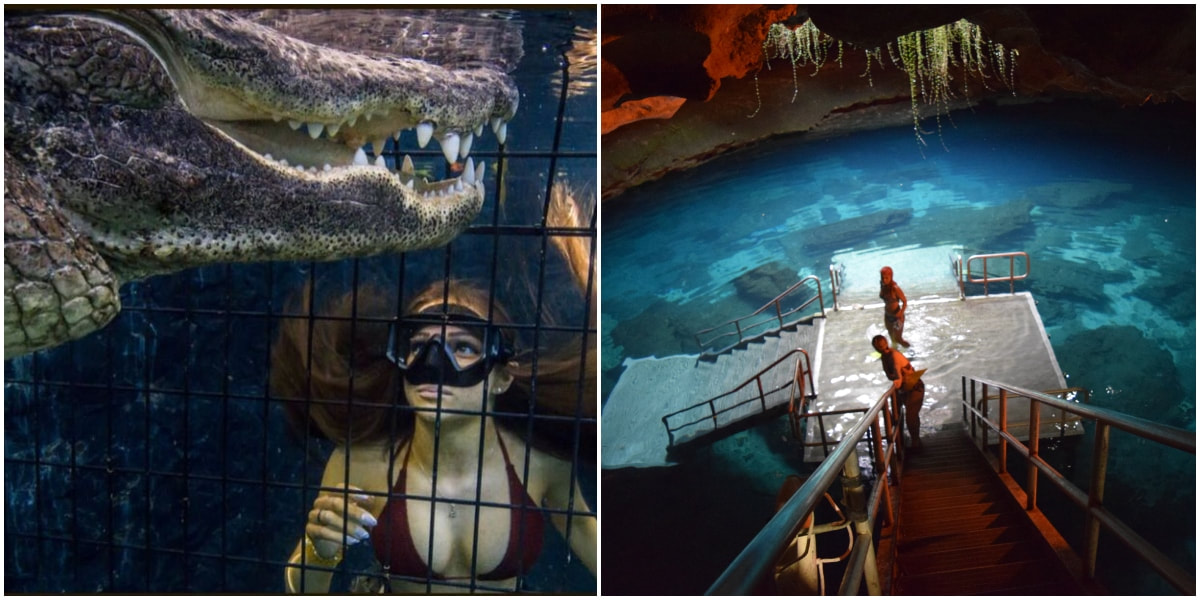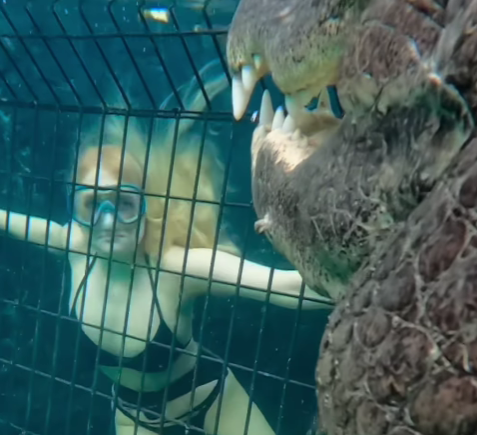|
Florida is one of the most popular tourist destinations in the United States, attracting millions of visitors every year. While one of the main reasons for its popularity is its sunny warm weather throughout the year, Florida is also home to some of the most beautiful beaches, famous theme parks, cultural offerings, and natural wonders, all of which when combined with Florida's excellent hospitality and tourist infrastructure, make it a top choice for vacationers seeking a fun and memorable experience. So, if you are one of the many who come here for an unforgettable experience you can't replicate anywhere else, this list of unique activities you can only do in Florida may help you decide on what to uncover next! Swim with manatees in Crystal RiverCrystal River, Florida is known for its large population of West Indian manatees, which are a subspecies of the manatee. These gentle giants are herbivorous mammals that can weigh up to 1,200 pounds and grow up to 13 feet long. During the winter months, manatees migrate to the warmer waters of Crystal River and Kings Bay to escape the colder temperatures in the Gulf of Mexico. The waters in this area are fed by warm springs, which provide a consistent source of warm water that the manatees need to survive. Crystal River is one of the few places in the world where people can legally interact with manatees in their natural habitat. Visitors can go on guided tours to swim or snorkel with the manatees, but it is important to remember that these are protected animals and must be treated with respect. It is illegal to touch, chase, or disturb manatees in any way, and doing so can result in fines or even jail time. Learn more about swimming with manatees in Florida here. Swim with alligatorsThe American alligator (Alligator mississippiensis) is a large, freshwater reptile that can be found throughout the state, particularly in the wetlands and marshes of the Florida Everglades. They are also found in other habitats such as lakes, rivers, and ponds, and sometimes even in swimming pools and golf course water hazards. Adult American alligators can grow up to 14 feet long and weigh over 1,000 pounds, though most are smaller than this. They have a broad, rounded snout, unlike the narrower snout of the American crocodile. Their skin is dark green or black, with a rough texture and a series of bony plates, called scutes, running down their back. Those who would like to walk on the wild side can do with a swimming tour offered by wildlife biologist, conservationist, and gator-guru Christopher Gillette. Gillette offers the once in a lifetime chance to safely swim with rescued nuisance alligators in a controlled environment at his Florida alligator refuge. Learn more about Chris' gator tours through his Instagram here. See the largest coral reef system in the United States The Florida Department of Environmental Protection dubs Florida as "the only state in the continental United States with extensive shallow coral reef formations near its coasts". These reefs are home to a diverse range of wildlife and are incredibly important to the local ecosystems. The most well-known of these systems is the Florida Reef Tract, which is the third-largest coral reef system in the world, stretching for over 350 miles along the state's southeastern coast. The Florida Reef Tract is made up of a variety of coral species, including elkhorn coral, staghorn coral, and brain coral. There are plenty of charters in South Florida that will take you snorkeling and diving around the reefs. Find out more about Florida's coral reef here. Swim in a sinkholeFlorida is full of sinkholes, but none quite like Devil's Den. This prehistoric underground spring is located in Williston, Florida, about two hours north of Orlando. It is a unique geological formation that has been used as a popular diving and snorkeling spot for many years. The spring gets its name from the steam rising from the surface, which was thought to resemble smoke coming out of the entrance to hell. Devil's Den is actually a collapsed underground cave system that exposes a crystal-clear, freshwater pool with a depth of up to 54 feet. The water temperature remains at a constant 72 degrees Fahrenheit year-round, making it a popular destination for divers and snorkelers. The pool is surrounded by a beautiful, natural landscape with towering trees, rock formations, and ferns, which make it a popular spot for nature lovers and photographers as well. The water in the pool is so clear that visitors can see the ancient rock formations and the fish swimming below. Devil's Den is not only a recreational spot, but also an important archaeological site. The prehistoric remains of extinct animals have been discovered in the Den, including the bones of mastodons, saber-toothed cats, giant ground sloths and even early human remains. The fossils and artifacts from the site provide valuable insights into the ecology and human history of the region. Visitors to Devil's Den can explore the underwater world of the spring on a guided snorkeling or diving tour, which is offered year-round. The site also has a diving shop and equipment rental on site, as well as a campground and cabins for those who wish to stay a while and thoroughly explore an enchanting blue basin. To learn more about Devil's Den click here. Dig up handfuls of fossilized shark teethVenice, Florida is known as the "Shark Tooth Capital of the World" because of the abundance of shark teeth that can be found on its beaches. The area's location on the Gulf of Mexico and its geology make it an ideal place for finding these fossils. The Venice area was once part of a shallow sea that covered much of Florida, and the region's sandy beaches are littered with fossilized shark teeth that have been deposited over millions of years. The most common types of shark teeth found in Venice belong to extinct species such as the megalodon, which could grow up to 60 feet long, and the mako shark, which is still around today but in much smaller numbers. Shark teeth can be found on the beaches of Venice year-round, but the best time to look for them is after a storm or during low tide when more of the sandy beach is exposed. Collecting shark teeth is a popular activity for visitors to the area, and there are many tours and guides available to help people find and identify the teeth. It's important to note that collecting shark teeth on public beaches in Venice is legal as long as the teeth are not still attached to a live shark. However, it's important to respect the environment and not disturb the beach ecosystem while searching for teeth. If you find a tooth that you believe may be rare or valuable, it's best to have it appraised by a professional before selling or trading it. Find out more about Venice's shark tooth collecting opportunities here. Spot wild American crocodilesThe American crocodile (Crocodylus acutus) is a large reptile that can be found in parts of Florida, particularly in the southern tip of the state in the Everglades and the surrounding areas. They are a protected species in the United States and are listed as threatened under the Endangered Species Act. They are a large, carnivorous reptile that can grow up to 20 feet in length and weigh as much as 2,000 pounds. Crocs have a narrow snout that distinguishes them from the alligator, which has a broader, more rounded snout. They are also lighter in color than alligators, with a gray-green or olive-brown hue. The American crocodile is a shy and reclusive species, and encounters with humans are rare. They are more commonly found in brackish habitats, such as mangrove swamps, saltwater lagoons, and tidal creeks. They are also found in the Florida Keys, where they inhabit shallow bays and lagoons. You can take airboat tours in Florida that will help you spot one of these rare creatures, or maybe one will find you the next time you're lounging on the beach. Kayak along a river of "wild" monkeysThere is a population of wild monkeys living at Silver Springs State Park in Florida. The monkeys are actually rhesus macaques, a species of Old World monkeys native to parts of Asia. The monkeys were brought to the area sometime around the 1930s as part of a plan to create a jungle-like atmosphere for the Silver Springs tourist attraction. The monkeys were allowed to roam free on an island in the Silver River, which is a major water source for the park. Over time, they escaped from the island and established a population in the surrounding area. Today, the population is estimated to be around 200 individuals, and they are often seen in and around the park, particularly near the river and on hiking trails. While the monkeys are a popular attraction for visitors to Silver Springs, they can also be a nuisance and sometimes cause damage to property. There have also been concerns about the monkeys' impact on the local ecosystem, as they are not native to the area and can potentially spread diseases to other wildlife and possibly even humans. In recent years, efforts have been made to manage the monkey population and prevent their spread outside of the park. The Florida Fish and Wildlife Conservation Commission has been conducting research on the monkeys' behavior and ecology to better understand their impact on the environment. If you encounter the monkeys while kayaking down Silver Springs, it's important to remember that they are wild animals and should be treated with caution and respect. Feeding or approaching the monkeys is prohibited, as it can be dangerous for both the animals and people. A more contained "wild" monkey encounter can be found at Homosassa's Monkey Island, which you can read about here.
0 Comments
Your comment will be posted after it is approved.
Leave a Reply. |
CATEGORIES |
|
|
Vertical Divider
|
Can't get enough?Uncover more of Florida through our channels below!
|
© COPYRIGHT 2015. ALL RIGHTS RESERVED.








 RSS Feed
RSS Feed